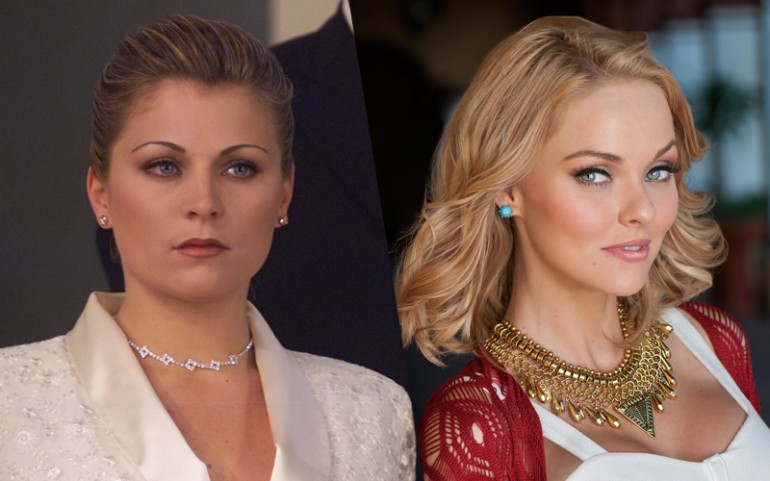Karma, Crisis and Creation
A Favorita was João Emanuel Carneiro’s third project for Rede Globo and his first telenovela to air in the primetime slot. It was a creative, bold effort, in which viewers are introduced to two main characters who tell two competing accounts of the same murder. The audience is led to believe that either could be telling the truth, until the turning point – halfway through the story – in which we learn the truth via flashbacks.
Carneiro’s writing process began years before the telenovela was greenlit by Rede Globo. His original idea was to write an innovative piece without the classic telenovela female protagonist. In his early talks with the studio, the telenovela was renamed twice. Originally, the author intended to call it Karma or Final Judgment. However, the Rede Globo directors decided for A Favorita, which they believed would strengthen the idea of people siding with one of the main characters.
Right from the beginning, João Emanuel Carneiro had a clear vision of what he wanted his main characters to look like. Actresses Claudia Raia and Patricia Pilar were promptly cast as the rivals Donatella and Flora. The casting of supporting characters, however, did not go as smoothly. According to Rede Globo records, well-established primetime star Priscila Fantin (Esperanza) was originally considered for the role of Lara, but turned down the offer to treat for deep depression. 80’s teenage heartthrob Fabio Assunção also rejected the role to play Dodi due to his struggle with drugs.
Tension also built up between the writer and the cast during production. Halfway through the story, actress Angela Vieira threatened to leave due to her character’s poor development. To keep her in the story, Carneiro created a subplot in which she had been in a previous relationship with a recurring character (Congressman Romildo) and developed a storyline in which her son suffers a serious accident.
This clash between writer and cast did not always result in negative outcomes. During the telenovela production, Juliana Paes was invited to be the lead in Caminho das Índias – which was written to replace A Favorita in the primetime slot. The writer agreed to kill her character off to allow her to accept the offer. Carneiro and Rede Globo also considered audience criticism, which had a washback effect in the production. Iran Malfitano, who was originally invited for a two-episode cameo, ended up being promoted to a recurring character due to the critical acclaim he received.
A Favorita’s ambitious premise reaches beyond its storyline and its all-star cast. Several arcs of the telenovela were shot on location in Sao Paulo city, the countryside of Sao Paulo state and Argentina. Besides that, five fictional zones were built at Estudios Globo (former Projac) including an entire working village, a country house with its gardens, an entire favela (slum) and a greenhouse. The attention to detail was such that the houses in the working village were built using reforestation trees, as it would be consonant with the philosophy of the villagers. Similarly, art producer Angela Melman made sure that every material in the fictional newsroom received a crafted visual brand designed to represent the newspaper.
Wardrobe also plays an important role in the storytelling. Under the guidance of costume designer Marie Salles, the main characters had costumes designed to influence viewers’ perceptions of who was telling the truth. Flora, who had just been released from prison, wears timeless and poorer costumes that illustrate the time lapse and to create more sympathy with the audience. To add to her innocent look, Patricia Pillar (Flora) got a fictional back tattoo with an illustration of a star with wings: which evokes angelical imagery. Contrastingly, Donatella mixes elements of country and European fashion. Her outfits create a link between her past as a country singer and her current status as a wealthy businesswoman.
Men’s wardrobe also helps tell the story in creative ways. Dodi, Donatella’s husband, wears bright colors, bracelets and rings – a visual brand of crooks in Brazil. Whenever he stands with his wife, he feeds the audience with the suspicion that Donatella might not be trustworthy.
A Favorita meets Rede Globo’s standards of production excellence while innovating the genre and reshaping television. Its writer, cast, sets and wardrobe come together to deliver a tightly knit story filled with rich details carefully crafted to divert viewers’ attention. As the audience is caught in a web of mystery and lies, the telenovela brings a breath of fresh air to the primetime slot.
If you are interested in the role of music in production, read my article How "A Favorita" Determined Our Favorite Songs.
Sources:


Wow, Jean this was a fascinating read! And well written, too. I'd never heard of A Favorita before, and now I want to check it out (I even found myself looking up characters and the studios to see what exactly you were describing). I absolutely ate up the gossip between the writers and actors, and it made me wonder if any of the same types of situations happened in the production of my telenovela. Because of all the thought that went into the writing, casting, styling, and shooting, it's clear that A Favorita is a telenovela of high quality. Thanks for taking me through all the details!
ReplyDelete